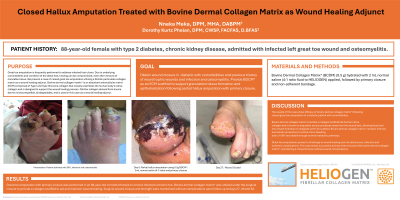Case Series/Study
(CS-095) Closed Great Toe Amputation Treated with Bovine Dermal Collagen Matrix as Wound Healing Adjunct

Great toe amputation is frequently performed to address infected foot ulcers. Due to underlying comorbidities and condition of the distal foot, healing can be compromised, even after removal of nonviable tissue.
We present a case of closed great toe amputation utilizing a fibrillar particulate collagen matrix as a wound healing adjunct. Bovine dermal collagen matrix* is an absorbent extracellular matrix (ECM) comprised of Type I and Type III bovine collagen that closely resembles the human body’s native collagen and is designed to support the wound healing process. Fibrillar collagen derived from bovine dermis is biocompatible, biodegradable, and is used in this case as a wound healing adjunct.
Methods:
88-year-old female with type 2 diabetes, CKD3, admitted with infected left great toe wound and osteomyelitis.
Results:
Great toe amputation with primary closure was performed in an 88-year-old comorbid female to remove infected ischemic toe. Bovine dermal collagen matrix* was utilized under the surgical closure to provide a collagen scaffold to aid and maintain wound healing. Surgical wound closure and strength were maintained without complications upon follow up at days 27, 49 and 83.
Discussion:
amputation in a diabetic patient with comorbidities.
Bovine dermal collagen matrix* provides a collagen scaffold like human native collagen and is known to sequester excess proteases away from the wound bed, allowing blood and new vessel formation to integrate within its scaffold. Bovine dermal collagen matrix* contains intrinsic hemostatic properties to control minor bleeding and is 100% resorbable through normal metabolic pathways.
Distal toe amputations present a challenge to wound healing and risk dehiscence, infection and ischemic complications. This case shows successful primary intent closure with bovine dermal collagen matrix*, maintaining a closed incision without wound complications.
*HELIOGEN, Mimedx, Inc., Marrietta, GA

.jpg)